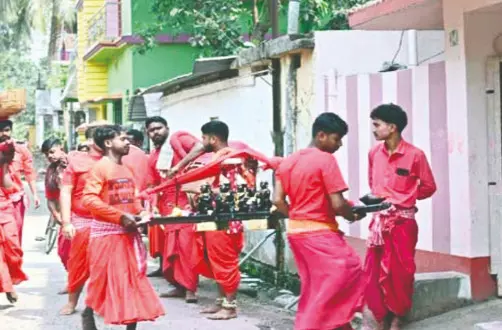
BALURGHAT, April 14 -- With the end of the Bengali calendar year, the festive spirit of Gajan has swept across North Bengal. In celebration of this age-old tradition, the 34th annual Charak festival was held on Monday at the Chakbhabani Smasan Kali Temple in Balurghat.
A major attraction of the event was the performance of the traditional "Hajra's dance", where Gajan devotees, dressed as Lord Shiva's followers, Chamunda and spirits, entertained the crowd with dramatic, colourful displays. The event followed an all-night Hajra puja, a ritual deeply rooted in local religious practices. The festival ground was brimming with enthusiastic spectators. Subrata Roy, a Gajan devotee, said: "Like every year, we worked hard to make this event a success." Anita Das, a visitor, shared her experience: "This was my first time witnessing Hajra's dance. It was truly unique. I hope this cultural heritage remains preserved for future generations."
Historically, Gajan sannyasis would be invited by households to perform the "Del" ritual in the evening before Charak puja.
Women would welcome them with reverence and the evening would continue with devotional songs and folk dances. However, these customs are now nearly forgotten, with researchers attributing the decline to changing family structures and modern lifestyles.
Gajan sannyasis begin their rituals a month in advance, wearing red attire, practicing strict abstinence and collecting donations for the upcoming puja.
They avoid oil, eat vegetarian meals and roam the streets in deity costumes. A decade ago, the "Del" tradition was still vibrant in Balurghat, where women would offer puja to sacred platforms representing various gods.
While the festival continues to be celebrated with devotion in Balurghat, concerns remain about its gradual decline. Yet, many still hope that the deep-rooted cultural essence of Gajan and Hajra will survive the test of time.
Historian Samit Ghosh laments the declining popularity of Gajan and Hajra performances in the district. "Economic uncertainty and the rise of nuclear families are major reasons," he explained.
"These artists cannot sustain their livelihood from just a three-day festival. Additionally, modern distractions like mobile phones and social media reels are distancing the younger generation from traditional culture."
Published by HT Digital Content Services with permission from Millennium Post.
